Dietary Intake Assessment and Analysis Report for Candice, 19
VerifiedAdded on 2020/03/16
|12
|4600
|188
Report
AI Summary
This report presents a dietary analysis based on a two-day food diary completed by a 19-year-old female, Candice. The assessment evaluates her eating habits against the Australian Dietary Guidelines, examining the intake of various food groups and discretionary foods. The report highlights areas where her diet aligns with or deviates from the recommended guidelines. Furthermore, it analyzes the intake of three chosen nutrients: calcium, iron, and dietary fiber, comparing them to the recommended daily intakes (RDIs) and adequate intakes (AIs). The analysis includes a critical evaluation of the foods and beverages contributing to nutrient levels, identifying both deficiencies and excesses. The report suggests dietary adjustments to meet the nutritional requirements and promotes a holistic approach to health and well-being, emphasizing the importance of balanced eating habits and conscious food choices.
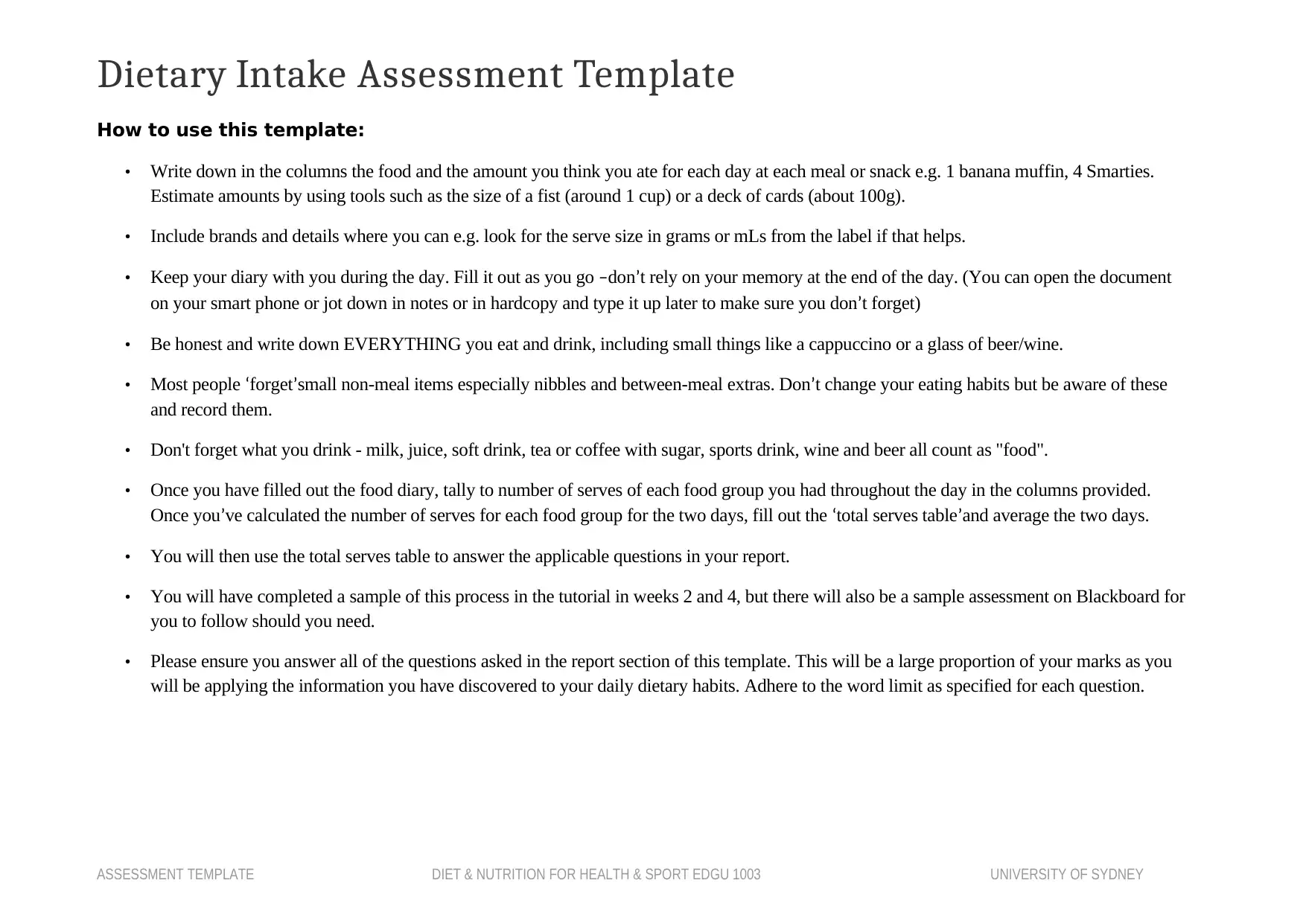
Dietary Intake Assessment Template
How to use this template:
• Write down in the columns the food and the amount you think you ate for each day at each meal or snack e.g. 1 banana muffin, 4 Smarties.
Estimate amounts by using tools such as the size of a fist (around 1 cup) or a deck of cards (about 100g).
• Include brands and details where you can e.g. look for the serve size in grams or mLs from the label if that helps.
• Keep your diary with you during the day. Fill it out as you go –don’t rely on your memory at the end of the day. (You can open the document
on your smart phone or jot down in notes or in hardcopy and type it up later to make sure you don’t forget)
• Be honest and write down EVERYTHING you eat and drink, including small things like a cappuccino or a glass of beer/wine.
• Most people ‘forget’small non-meal items especially nibbles and between-meal extras. Don’t change your eating habits but be aware of these
and record them.
• Don't forget what you drink - milk, juice, soft drink, tea or coffee with sugar, sports drink, wine and beer all count as "food".
• Once you have filled out the food diary, tally to number of serves of each food group you had throughout the day in the columns provided.
Once you’ve calculated the number of serves for each food group for the two days, fill out the ‘total serves table’and average the two days.
• You will then use the total serves table to answer the applicable questions in your report.
• You will have completed a sample of this process in the tutorial in weeks 2 and 4, but there will also be a sample assessment on Blackboard for
you to follow should you need.
• Please ensure you answer all of the questions asked in the report section of this template. This will be a large proportion of your marks as you
will be applying the information you have discovered to your daily dietary habits. Adhere to the word limit as specified for each question.
ASSESSMENT TEMPLATE DIET & NUTRITION FOR HEALTH & SPORT EDGU 1003 UNIVERSITY OF SYDNEY
How to use this template:
• Write down in the columns the food and the amount you think you ate for each day at each meal or snack e.g. 1 banana muffin, 4 Smarties.
Estimate amounts by using tools such as the size of a fist (around 1 cup) or a deck of cards (about 100g).
• Include brands and details where you can e.g. look for the serve size in grams or mLs from the label if that helps.
• Keep your diary with you during the day. Fill it out as you go –don’t rely on your memory at the end of the day. (You can open the document
on your smart phone or jot down in notes or in hardcopy and type it up later to make sure you don’t forget)
• Be honest and write down EVERYTHING you eat and drink, including small things like a cappuccino or a glass of beer/wine.
• Most people ‘forget’small non-meal items especially nibbles and between-meal extras. Don’t change your eating habits but be aware of these
and record them.
• Don't forget what you drink - milk, juice, soft drink, tea or coffee with sugar, sports drink, wine and beer all count as "food".
• Once you have filled out the food diary, tally to number of serves of each food group you had throughout the day in the columns provided.
Once you’ve calculated the number of serves for each food group for the two days, fill out the ‘total serves table’and average the two days.
• You will then use the total serves table to answer the applicable questions in your report.
• You will have completed a sample of this process in the tutorial in weeks 2 and 4, but there will also be a sample assessment on Blackboard for
you to follow should you need.
• Please ensure you answer all of the questions asked in the report section of this template. This will be a large proportion of your marks as you
will be applying the information you have discovered to your daily dietary habits. Adhere to the word limit as specified for each question.
ASSESSMENT TEMPLATE DIET & NUTRITION FOR HEALTH & SPORT EDGU 1003 UNIVERSITY OF SYDNEY
Paraphrase This Document
Need a fresh take? Get an instant paraphrase of this document with our AI Paraphraser
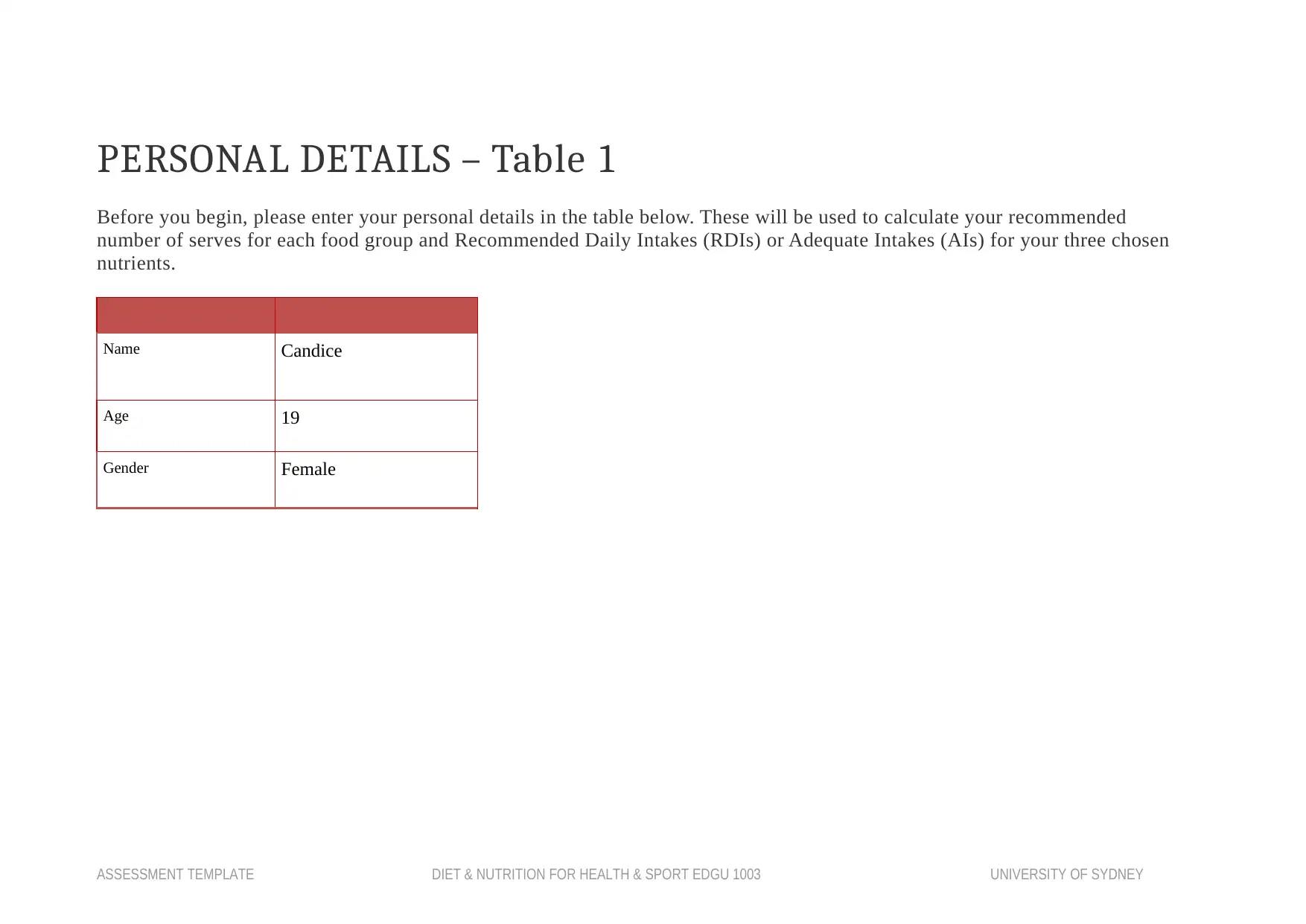
PERSONAL DETAILS – Table 1
Before you begin, please enter your personal details in the table below. These will be used to calculate your recommended
number of serves for each food group and Recommended Daily Intakes (RDIs) or Adequate Intakes (AIs) for your three chosen
nutrients.
Name Candice
Age 19
Gender Female
ASSESSMENT TEMPLATE DIET & NUTRITION FOR HEALTH & SPORT EDGU 1003 UNIVERSITY OF SYDNEY
Before you begin, please enter your personal details in the table below. These will be used to calculate your recommended
number of serves for each food group and Recommended Daily Intakes (RDIs) or Adequate Intakes (AIs) for your three chosen
nutrients.
Name Candice
Age 19
Gender Female
ASSESSMENT TEMPLATE DIET & NUTRITION FOR HEALTH & SPORT EDGU 1003 UNIVERSITY OF SYDNEY
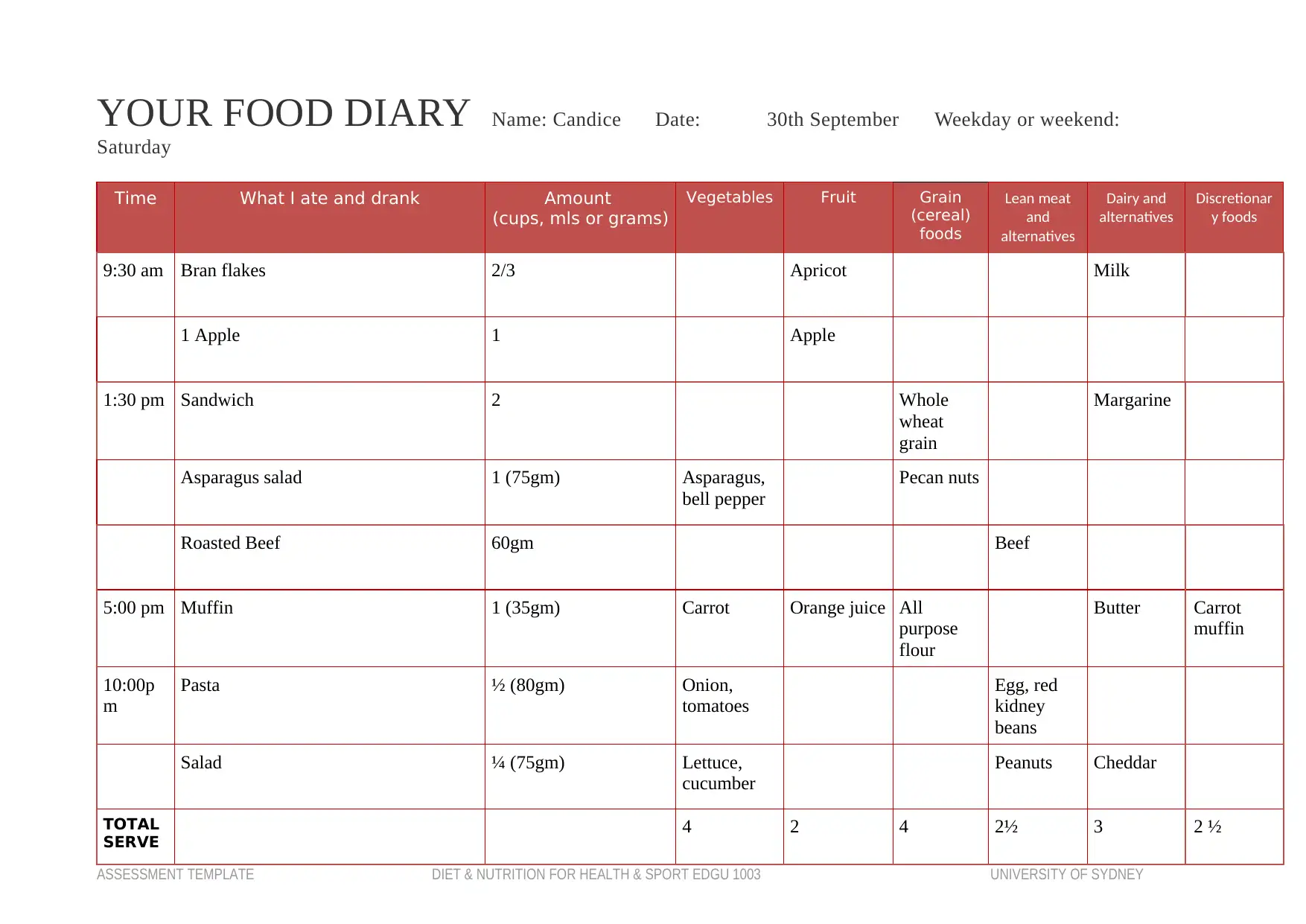
YOUR FOOD DIARY Name: Candice Date: 30th September Weekday or weekend:
Saturday
Time What I ate and drank Amount
(cups, mls or grams)
Vegetables Fruit Grain
(cereal)
foods
Lean meat
and
alternatives
Dairy and
alternatives
Discretionar
y foods
9:30 am Bran flakes 2/3 Apricot Milk
1 Apple 1 Apple
1:30 pm Sandwich 2 Whole
wheat
grain
Margarine
Asparagus salad 1 (75gm) Asparagus,
bell pepper
Pecan nuts
Roasted Beef 60gm Beef
5:00 pm Muffin 1 (35gm) Carrot Orange juice All
purpose
flour
Butter Carrot
muffin
10:00p
m
Pasta ½ (80gm) Onion,
tomatoes
Egg, red
kidney
beans
Salad ¼ (75gm) Lettuce,
cucumber
Peanuts Cheddar
TOTAL
SERVE 4 2 4 2½ 3 2 ½
ASSESSMENT TEMPLATE DIET & NUTRITION FOR HEALTH & SPORT EDGU 1003 UNIVERSITY OF SYDNEY
Saturday
Time What I ate and drank Amount
(cups, mls or grams)
Vegetables Fruit Grain
(cereal)
foods
Lean meat
and
alternatives
Dairy and
alternatives
Discretionar
y foods
9:30 am Bran flakes 2/3 Apricot Milk
1 Apple 1 Apple
1:30 pm Sandwich 2 Whole
wheat
grain
Margarine
Asparagus salad 1 (75gm) Asparagus,
bell pepper
Pecan nuts
Roasted Beef 60gm Beef
5:00 pm Muffin 1 (35gm) Carrot Orange juice All
purpose
flour
Butter Carrot
muffin
10:00p
m
Pasta ½ (80gm) Onion,
tomatoes
Egg, red
kidney
beans
Salad ¼ (75gm) Lettuce,
cucumber
Peanuts Cheddar
TOTAL
SERVE 4 2 4 2½ 3 2 ½
ASSESSMENT TEMPLATE DIET & NUTRITION FOR HEALTH & SPORT EDGU 1003 UNIVERSITY OF SYDNEY
⊘ This is a preview!⊘
Do you want full access?
Subscribe today to unlock all pages.

Trusted by 1+ million students worldwide
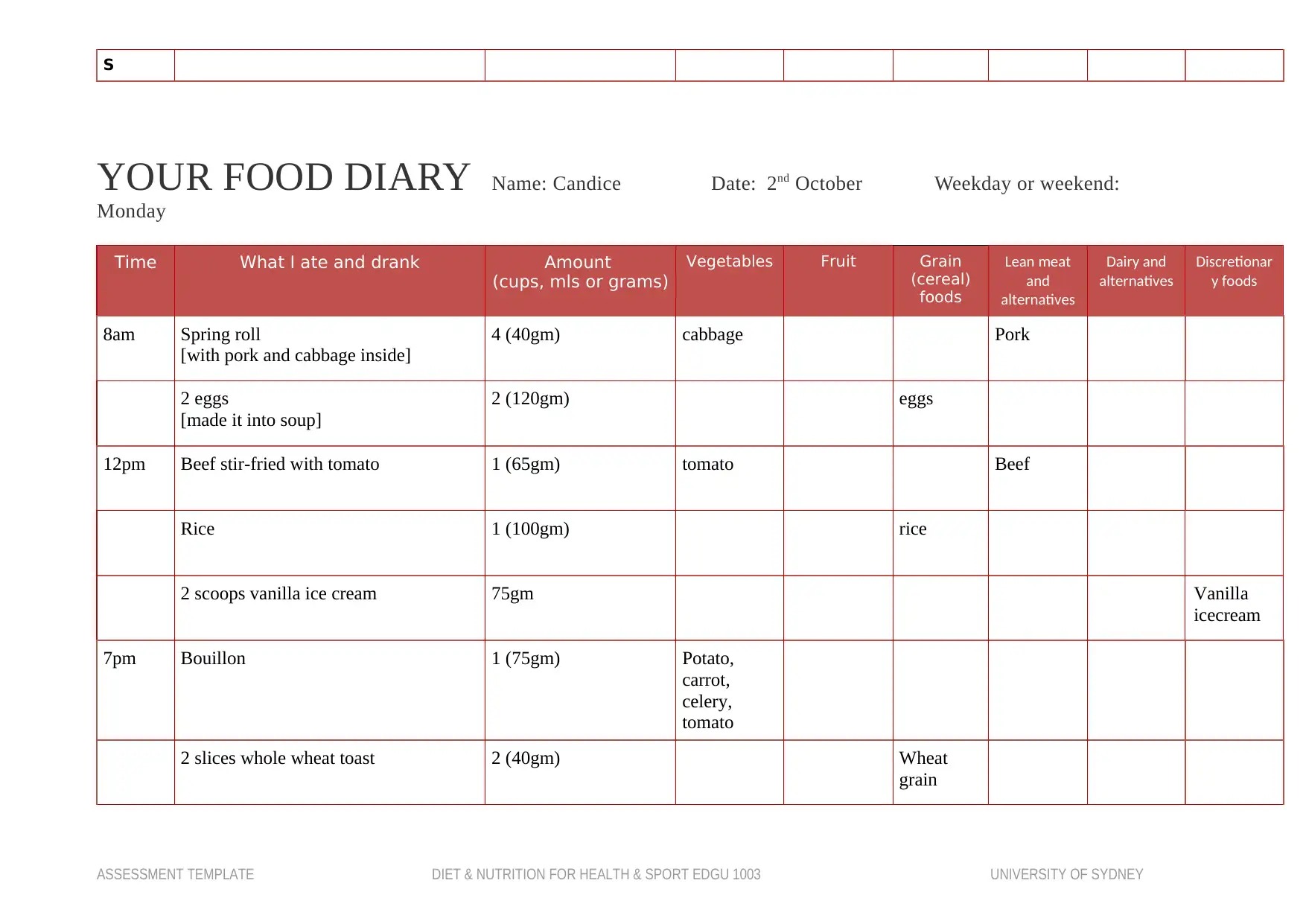
S
YOUR FOOD DIARY Name: Candice Date: 2nd October Weekday or weekend:
Monday
Time What I ate and drank Amount
(cups, mls or grams)
Vegetables Fruit Grain
(cereal)
foods
Lean meat
and
alternatives
Dairy and
alternatives
Discretionar
y foods
8am Spring roll
[with pork and cabbage inside]
4 (40gm) cabbage Pork
2 eggs
[made it into soup]
2 (120gm) eggs
12pm Beef stir-fried with tomato 1 (65gm) tomato Beef
Rice 1 (100gm) rice
2 scoops vanilla ice cream 75gm Vanilla
icecream
7pm Bouillon 1 (75gm) Potato,
carrot,
celery,
tomato
2 slices whole wheat toast 2 (40gm) Wheat
grain
ASSESSMENT TEMPLATE DIET & NUTRITION FOR HEALTH & SPORT EDGU 1003 UNIVERSITY OF SYDNEY
YOUR FOOD DIARY Name: Candice Date: 2nd October Weekday or weekend:
Monday
Time What I ate and drank Amount
(cups, mls or grams)
Vegetables Fruit Grain
(cereal)
foods
Lean meat
and
alternatives
Dairy and
alternatives
Discretionar
y foods
8am Spring roll
[with pork and cabbage inside]
4 (40gm) cabbage Pork
2 eggs
[made it into soup]
2 (120gm) eggs
12pm Beef stir-fried with tomato 1 (65gm) tomato Beef
Rice 1 (100gm) rice
2 scoops vanilla ice cream 75gm Vanilla
icecream
7pm Bouillon 1 (75gm) Potato,
carrot,
celery,
tomato
2 slices whole wheat toast 2 (40gm) Wheat
grain
ASSESSMENT TEMPLATE DIET & NUTRITION FOR HEALTH & SPORT EDGU 1003 UNIVERSITY OF SYDNEY
Paraphrase This Document
Need a fresh take? Get an instant paraphrase of this document with our AI Paraphraser
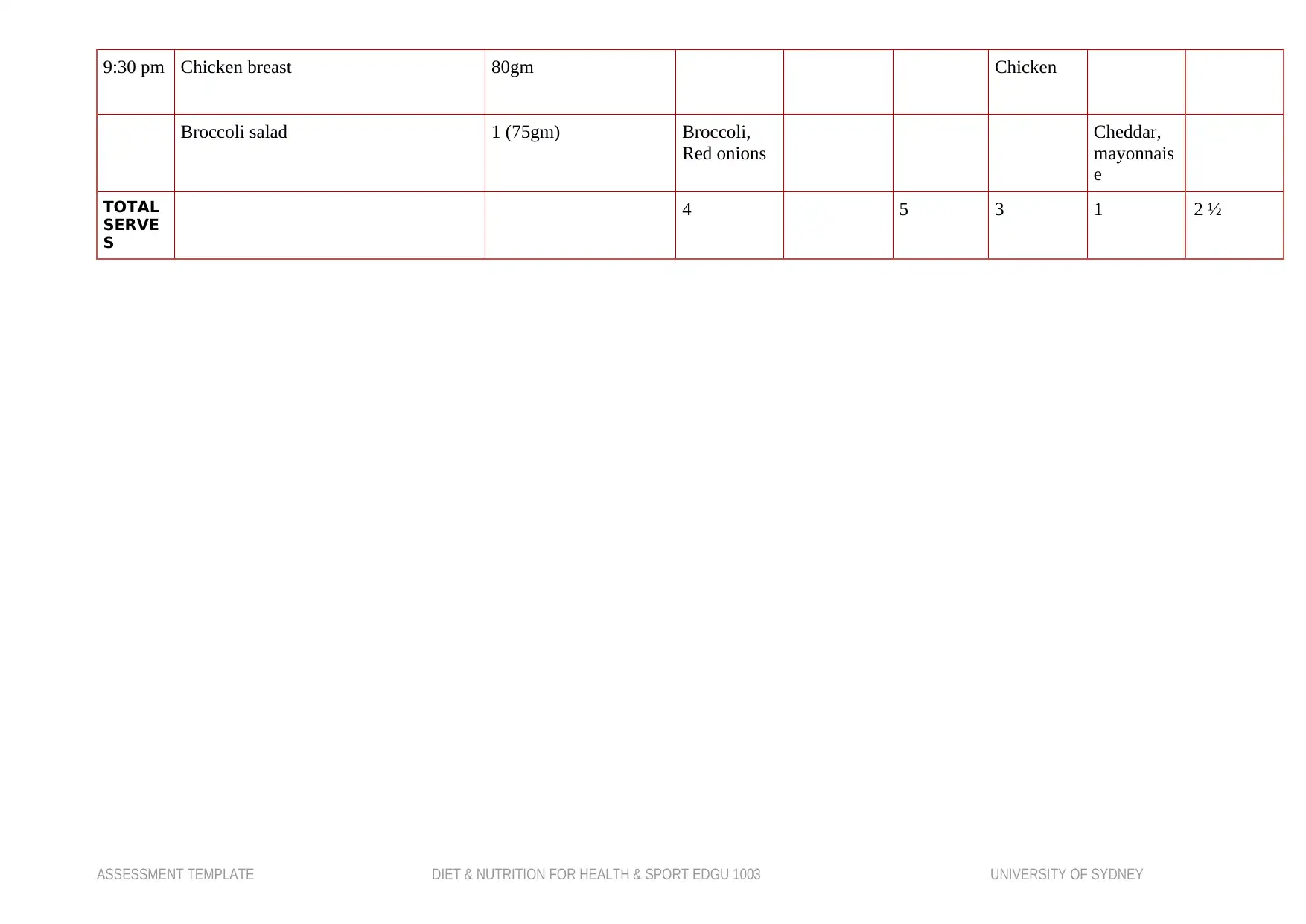
9:30 pm Chicken breast 80gm Chicken
Broccoli salad 1 (75gm) Broccoli,
Red onions
Cheddar,
mayonnais
e
TOTAL
SERVE
S
4 5 3 1 2 ½
ASSESSMENT TEMPLATE DIET & NUTRITION FOR HEALTH & SPORT EDGU 1003 UNIVERSITY OF SYDNEY
Broccoli salad 1 (75gm) Broccoli,
Red onions
Cheddar,
mayonnais
e
TOTAL
SERVE
S
4 5 3 1 2 ½
ASSESSMENT TEMPLATE DIET & NUTRITION FOR HEALTH & SPORT EDGU 1003 UNIVERSITY OF SYDNEY
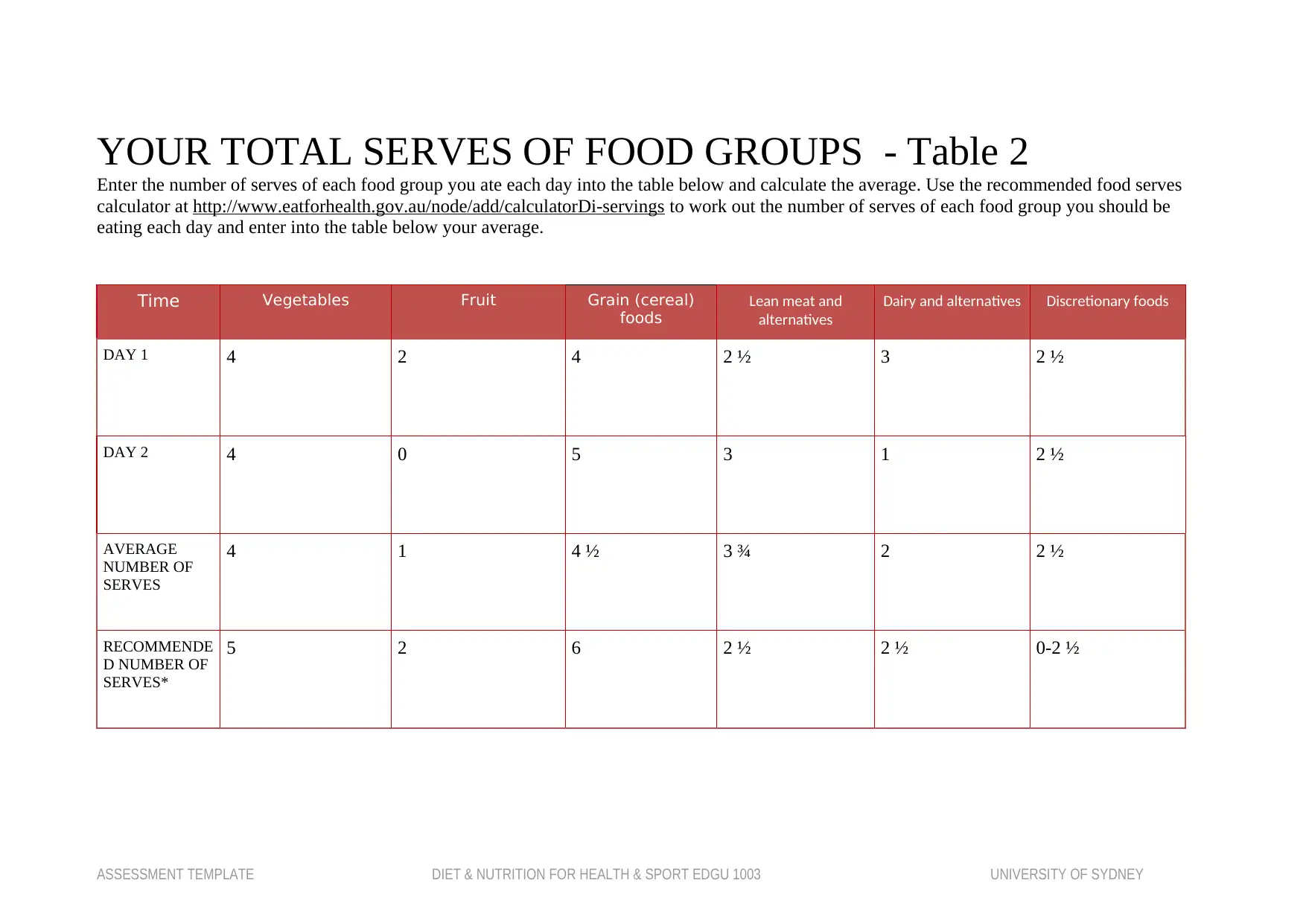
YOUR TOTAL SERVES OF FOOD GROUPS - Table 2
Enter the number of serves of each food group you ate each day into the table below and calculate the average. Use the recommended food serves
calculator at http://www.eatforhealth.gov.au/node/add/calculatorDi-servings to work out the number of serves of each food group you should be
eating each day and enter into the table below your average.
Time Vegetables Fruit Grain (cereal)
foods
Lean meat and
alternatives
Dairy and alternatives Discretionary foods
DAY 1 4 2 4 2 ½ 3 2 ½
DAY 2 4 0 5 3 1 2 ½
AVERAGE
NUMBER OF
SERVES
4 1 4 ½ 3 ¾ 2 2 ½
RECOMMENDE
D NUMBER OF
SERVES*
5 2 6 2 ½ 2 ½ 0-2 ½
ASSESSMENT TEMPLATE DIET & NUTRITION FOR HEALTH & SPORT EDGU 1003 UNIVERSITY OF SYDNEY
Enter the number of serves of each food group you ate each day into the table below and calculate the average. Use the recommended food serves
calculator at http://www.eatforhealth.gov.au/node/add/calculatorDi-servings to work out the number of serves of each food group you should be
eating each day and enter into the table below your average.
Time Vegetables Fruit Grain (cereal)
foods
Lean meat and
alternatives
Dairy and alternatives Discretionary foods
DAY 1 4 2 4 2 ½ 3 2 ½
DAY 2 4 0 5 3 1 2 ½
AVERAGE
NUMBER OF
SERVES
4 1 4 ½ 3 ¾ 2 2 ½
RECOMMENDE
D NUMBER OF
SERVES*
5 2 6 2 ½ 2 ½ 0-2 ½
ASSESSMENT TEMPLATE DIET & NUTRITION FOR HEALTH & SPORT EDGU 1003 UNIVERSITY OF SYDNEY
⊘ This is a preview!⊘
Do you want full access?
Subscribe today to unlock all pages.

Trusted by 1+ million students worldwide
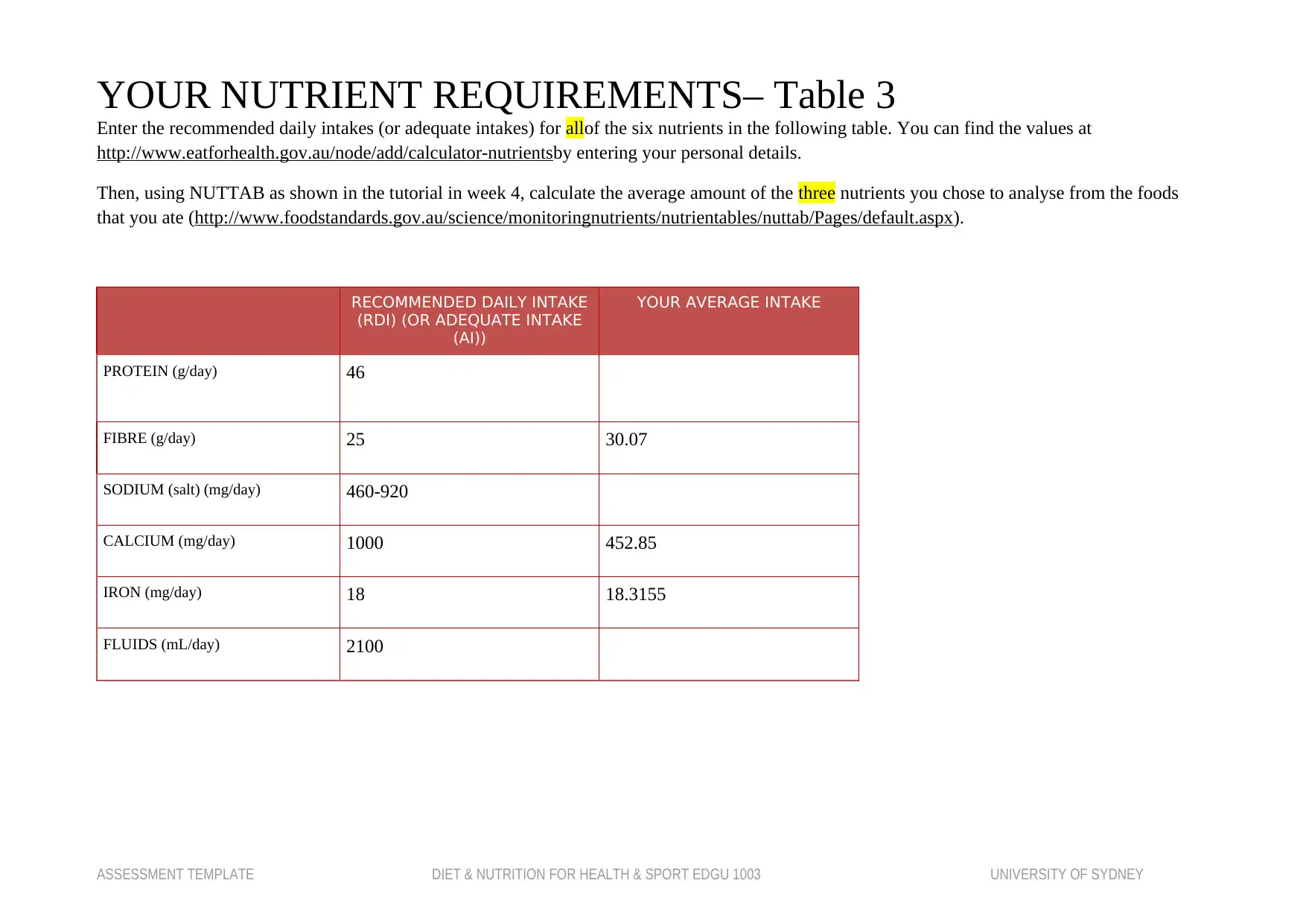
YOUR NUTRIENT REQUIREMENTS– Table 3
Enter the recommended daily intakes (or adequate intakes) for allof the six nutrients in the following table. You can find the values at
http://www.eatforhealth.gov.au/node/add/calculator-nutrientsby entering your personal details.
Then, using NUTTAB as shown in the tutorial in week 4, calculate the average amount of the three nutrients you chose to analyse from the foods
that you ate (http://www.foodstandards.gov.au/science/monitoringnutrients/nutrientables/nuttab/Pages/default.aspx).
RECOMMENDED DAILY INTAKE
(RDI) (OR ADEQUATE INTAKE
(AI))
YOUR AVERAGE INTAKE
PROTEIN (g/day) 46
FIBRE (g/day) 25 30.07
SODIUM (salt) (mg/day) 460-920
CALCIUM (mg/day) 1000 452.85
IRON (mg/day) 18 18.3155
FLUIDS (mL/day) 2100
ASSESSMENT TEMPLATE DIET & NUTRITION FOR HEALTH & SPORT EDGU 1003 UNIVERSITY OF SYDNEY
Enter the recommended daily intakes (or adequate intakes) for allof the six nutrients in the following table. You can find the values at
http://www.eatforhealth.gov.au/node/add/calculator-nutrientsby entering your personal details.
Then, using NUTTAB as shown in the tutorial in week 4, calculate the average amount of the three nutrients you chose to analyse from the foods
that you ate (http://www.foodstandards.gov.au/science/monitoringnutrients/nutrientables/nuttab/Pages/default.aspx).
RECOMMENDED DAILY INTAKE
(RDI) (OR ADEQUATE INTAKE
(AI))
YOUR AVERAGE INTAKE
PROTEIN (g/day) 46
FIBRE (g/day) 25 30.07
SODIUM (salt) (mg/day) 460-920
CALCIUM (mg/day) 1000 452.85
IRON (mg/day) 18 18.3155
FLUIDS (mL/day) 2100
ASSESSMENT TEMPLATE DIET & NUTRITION FOR HEALTH & SPORT EDGU 1003 UNIVERSITY OF SYDNEY
Paraphrase This Document
Need a fresh take? Get an instant paraphrase of this document with our AI Paraphraser
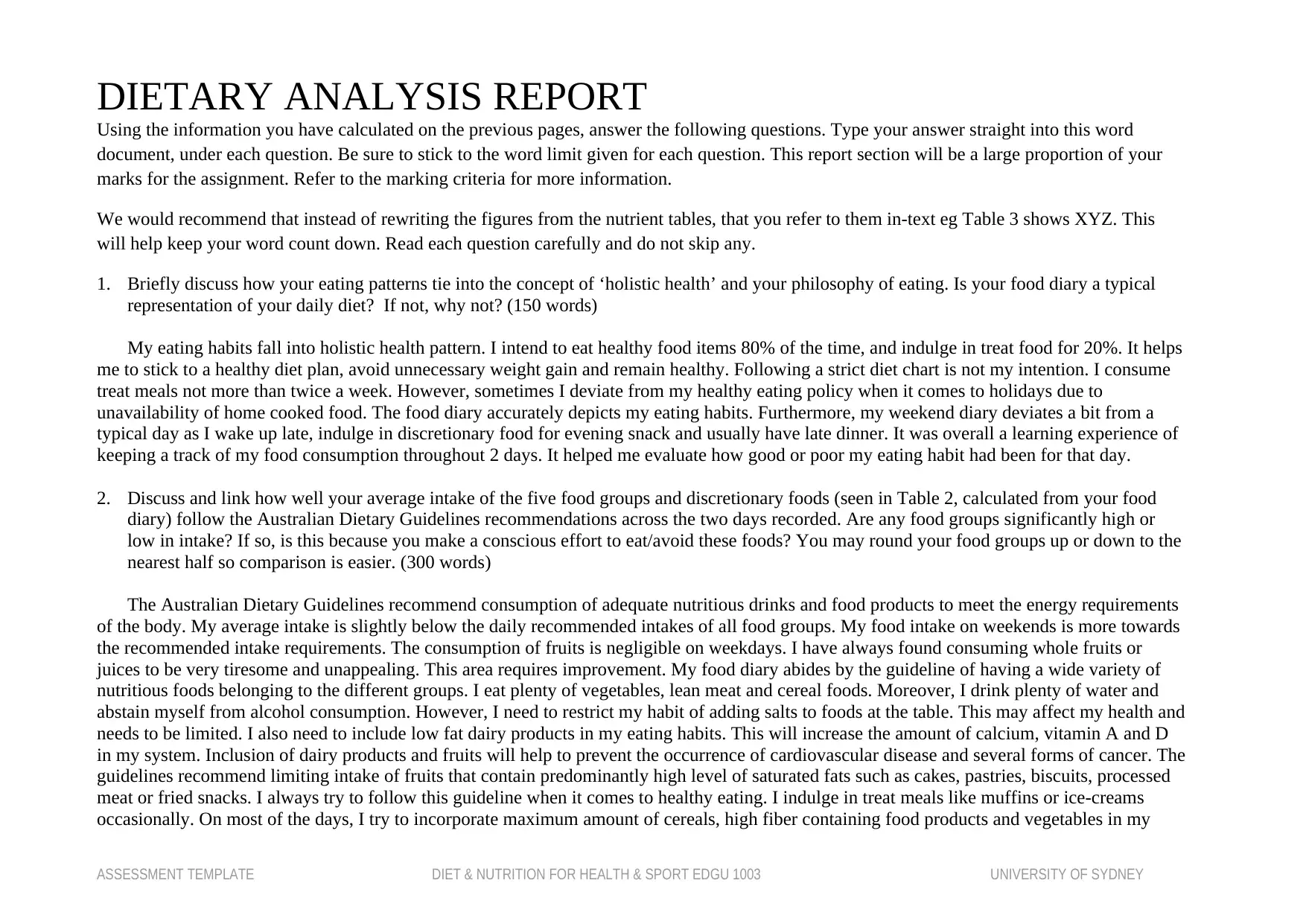
DIETARY ANALYSIS REPORT
Using the information you have calculated on the previous pages, answer the following questions. Type your answer straight into this word
document, under each question. Be sure to stick to the word limit given for each question. This report section will be a large proportion of your
marks for the assignment. Refer to the marking criteria for more information.
We would recommend that instead of rewriting the figures from the nutrient tables, that you refer to them in-text eg Table 3 shows XYZ. This
will help keep your word count down. Read each question carefully and do not skip any.
1. Briefly discuss how your eating patterns tie into the concept of ‘holistic health’ and your philosophy of eating. Is your food diary a typical
representation of your daily diet? If not, why not? (150 words)
My eating habits fall into holistic health pattern. I intend to eat healthy food items 80% of the time, and indulge in treat food for 20%. It helps
me to stick to a healthy diet plan, avoid unnecessary weight gain and remain healthy. Following a strict diet chart is not my intention. I consume
treat meals not more than twice a week. However, sometimes I deviate from my healthy eating policy when it comes to holidays due to
unavailability of home cooked food. The food diary accurately depicts my eating habits. Furthermore, my weekend diary deviates a bit from a
typical day as I wake up late, indulge in discretionary food for evening snack and usually have late dinner. It was overall a learning experience of
keeping a track of my food consumption throughout 2 days. It helped me evaluate how good or poor my eating habit had been for that day.
2. Discuss and link how well your average intake of the five food groups and discretionary foods (seen in Table 2, calculated from your food
diary) follow the Australian Dietary Guidelines recommendations across the two days recorded. Are any food groups significantly high or
low in intake? If so, is this because you make a conscious effort to eat/avoid these foods? You may round your food groups up or down to the
nearest half so comparison is easier. (300 words)
The Australian Dietary Guidelines recommend consumption of adequate nutritious drinks and food products to meet the energy requirements
of the body. My average intake is slightly below the daily recommended intakes of all food groups. My food intake on weekends is more towards
the recommended intake requirements. The consumption of fruits is negligible on weekdays. I have always found consuming whole fruits or
juices to be very tiresome and unappealing. This area requires improvement. My food diary abides by the guideline of having a wide variety of
nutritious foods belonging to the different groups. I eat plenty of vegetables, lean meat and cereal foods. Moreover, I drink plenty of water and
abstain myself from alcohol consumption. However, I need to restrict my habit of adding salts to foods at the table. This may affect my health and
needs to be limited. I also need to include low fat dairy products in my eating habits. This will increase the amount of calcium, vitamin A and D
in my system. Inclusion of dairy products and fruits will help to prevent the occurrence of cardiovascular disease and several forms of cancer. The
guidelines recommend limiting intake of fruits that contain predominantly high level of saturated fats such as cakes, pastries, biscuits, processed
meat or fried snacks. I always try to follow this guideline when it comes to healthy eating. I indulge in treat meals like muffins or ice-creams
occasionally. On most of the days, I try to incorporate maximum amount of cereals, high fiber containing food products and vegetables in my
ASSESSMENT TEMPLATE DIET & NUTRITION FOR HEALTH & SPORT EDGU 1003 UNIVERSITY OF SYDNEY
Using the information you have calculated on the previous pages, answer the following questions. Type your answer straight into this word
document, under each question. Be sure to stick to the word limit given for each question. This report section will be a large proportion of your
marks for the assignment. Refer to the marking criteria for more information.
We would recommend that instead of rewriting the figures from the nutrient tables, that you refer to them in-text eg Table 3 shows XYZ. This
will help keep your word count down. Read each question carefully and do not skip any.
1. Briefly discuss how your eating patterns tie into the concept of ‘holistic health’ and your philosophy of eating. Is your food diary a typical
representation of your daily diet? If not, why not? (150 words)
My eating habits fall into holistic health pattern. I intend to eat healthy food items 80% of the time, and indulge in treat food for 20%. It helps
me to stick to a healthy diet plan, avoid unnecessary weight gain and remain healthy. Following a strict diet chart is not my intention. I consume
treat meals not more than twice a week. However, sometimes I deviate from my healthy eating policy when it comes to holidays due to
unavailability of home cooked food. The food diary accurately depicts my eating habits. Furthermore, my weekend diary deviates a bit from a
typical day as I wake up late, indulge in discretionary food for evening snack and usually have late dinner. It was overall a learning experience of
keeping a track of my food consumption throughout 2 days. It helped me evaluate how good or poor my eating habit had been for that day.
2. Discuss and link how well your average intake of the five food groups and discretionary foods (seen in Table 2, calculated from your food
diary) follow the Australian Dietary Guidelines recommendations across the two days recorded. Are any food groups significantly high or
low in intake? If so, is this because you make a conscious effort to eat/avoid these foods? You may round your food groups up or down to the
nearest half so comparison is easier. (300 words)
The Australian Dietary Guidelines recommend consumption of adequate nutritious drinks and food products to meet the energy requirements
of the body. My average intake is slightly below the daily recommended intakes of all food groups. My food intake on weekends is more towards
the recommended intake requirements. The consumption of fruits is negligible on weekdays. I have always found consuming whole fruits or
juices to be very tiresome and unappealing. This area requires improvement. My food diary abides by the guideline of having a wide variety of
nutritious foods belonging to the different groups. I eat plenty of vegetables, lean meat and cereal foods. Moreover, I drink plenty of water and
abstain myself from alcohol consumption. However, I need to restrict my habit of adding salts to foods at the table. This may affect my health and
needs to be limited. I also need to include low fat dairy products in my eating habits. This will increase the amount of calcium, vitamin A and D
in my system. Inclusion of dairy products and fruits will help to prevent the occurrence of cardiovascular disease and several forms of cancer. The
guidelines recommend limiting intake of fruits that contain predominantly high level of saturated fats such as cakes, pastries, biscuits, processed
meat or fried snacks. I always try to follow this guideline when it comes to healthy eating. I indulge in treat meals like muffins or ice-creams
occasionally. On most of the days, I try to incorporate maximum amount of cereals, high fiber containing food products and vegetables in my
ASSESSMENT TEMPLATE DIET & NUTRITION FOR HEALTH & SPORT EDGU 1003 UNIVERSITY OF SYDNEY
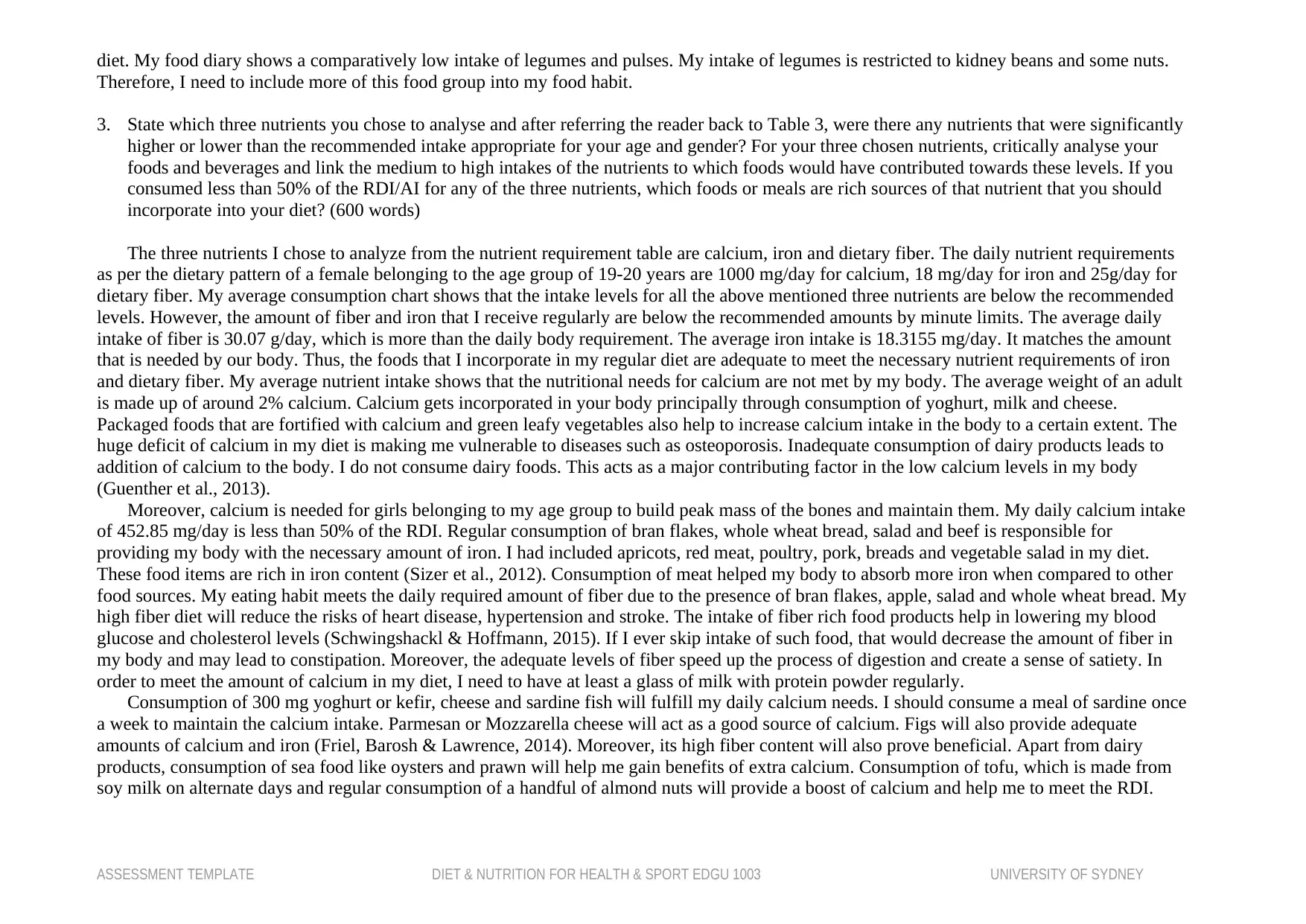
diet. My food diary shows a comparatively low intake of legumes and pulses. My intake of legumes is restricted to kidney beans and some nuts.
Therefore, I need to include more of this food group into my food habit.
3. State which three nutrients you chose to analyse and after referring the reader back to Table 3, were there any nutrients that were significantly
higher or lower than the recommended intake appropriate for your age and gender? For your three chosen nutrients, critically analyse your
foods and beverages and link the medium to high intakes of the nutrients to which foods would have contributed towards these levels. If you
consumed less than 50% of the RDI/AI for any of the three nutrients, which foods or meals are rich sources of that nutrient that you should
incorporate into your diet? (600 words)
The three nutrients I chose to analyze from the nutrient requirement table are calcium, iron and dietary fiber. The daily nutrient requirements
as per the dietary pattern of a female belonging to the age group of 19-20 years are 1000 mg/day for calcium, 18 mg/day for iron and 25g/day for
dietary fiber. My average consumption chart shows that the intake levels for all the above mentioned three nutrients are below the recommended
levels. However, the amount of fiber and iron that I receive regularly are below the recommended amounts by minute limits. The average daily
intake of fiber is 30.07 g/day, which is more than the daily body requirement. The average iron intake is 18.3155 mg/day. It matches the amount
that is needed by our body. Thus, the foods that I incorporate in my regular diet are adequate to meet the necessary nutrient requirements of iron
and dietary fiber. My average nutrient intake shows that the nutritional needs for calcium are not met by my body. The average weight of an adult
is made up of around 2% calcium. Calcium gets incorporated in your body principally through consumption of yoghurt, milk and cheese.
Packaged foods that are fortified with calcium and green leafy vegetables also help to increase calcium intake in the body to a certain extent. The
huge deficit of calcium in my diet is making me vulnerable to diseases such as osteoporosis. Inadequate consumption of dairy products leads to
addition of calcium to the body. I do not consume dairy foods. This acts as a major contributing factor in the low calcium levels in my body
(Guenther et al., 2013).
Moreover, calcium is needed for girls belonging to my age group to build peak mass of the bones and maintain them. My daily calcium intake
of 452.85 mg/day is less than 50% of the RDI. Regular consumption of bran flakes, whole wheat bread, salad and beef is responsible for
providing my body with the necessary amount of iron. I had included apricots, red meat, poultry, pork, breads and vegetable salad in my diet.
These food items are rich in iron content (Sizer et al., 2012). Consumption of meat helped my body to absorb more iron when compared to other
food sources. My eating habit meets the daily required amount of fiber due to the presence of bran flakes, apple, salad and whole wheat bread. My
high fiber diet will reduce the risks of heart disease, hypertension and stroke. The intake of fiber rich food products help in lowering my blood
glucose and cholesterol levels (Schwingshackl & Hoffmann, 2015). If I ever skip intake of such food, that would decrease the amount of fiber in
my body and may lead to constipation. Moreover, the adequate levels of fiber speed up the process of digestion and create a sense of satiety. In
order to meet the amount of calcium in my diet, I need to have at least a glass of milk with protein powder regularly.
Consumption of 300 mg yoghurt or kefir, cheese and sardine fish will fulfill my daily calcium needs. I should consume a meal of sardine once
a week to maintain the calcium intake. Parmesan or Mozzarella cheese will act as a good source of calcium. Figs will also provide adequate
amounts of calcium and iron (Friel, Barosh & Lawrence, 2014). Moreover, its high fiber content will also prove beneficial. Apart from dairy
products, consumption of sea food like oysters and prawn will help me gain benefits of extra calcium. Consumption of tofu, which is made from
soy milk on alternate days and regular consumption of a handful of almond nuts will provide a boost of calcium and help me to meet the RDI.
ASSESSMENT TEMPLATE DIET & NUTRITION FOR HEALTH & SPORT EDGU 1003 UNIVERSITY OF SYDNEY
Therefore, I need to include more of this food group into my food habit.
3. State which three nutrients you chose to analyse and after referring the reader back to Table 3, were there any nutrients that were significantly
higher or lower than the recommended intake appropriate for your age and gender? For your three chosen nutrients, critically analyse your
foods and beverages and link the medium to high intakes of the nutrients to which foods would have contributed towards these levels. If you
consumed less than 50% of the RDI/AI for any of the three nutrients, which foods or meals are rich sources of that nutrient that you should
incorporate into your diet? (600 words)
The three nutrients I chose to analyze from the nutrient requirement table are calcium, iron and dietary fiber. The daily nutrient requirements
as per the dietary pattern of a female belonging to the age group of 19-20 years are 1000 mg/day for calcium, 18 mg/day for iron and 25g/day for
dietary fiber. My average consumption chart shows that the intake levels for all the above mentioned three nutrients are below the recommended
levels. However, the amount of fiber and iron that I receive regularly are below the recommended amounts by minute limits. The average daily
intake of fiber is 30.07 g/day, which is more than the daily body requirement. The average iron intake is 18.3155 mg/day. It matches the amount
that is needed by our body. Thus, the foods that I incorporate in my regular diet are adequate to meet the necessary nutrient requirements of iron
and dietary fiber. My average nutrient intake shows that the nutritional needs for calcium are not met by my body. The average weight of an adult
is made up of around 2% calcium. Calcium gets incorporated in your body principally through consumption of yoghurt, milk and cheese.
Packaged foods that are fortified with calcium and green leafy vegetables also help to increase calcium intake in the body to a certain extent. The
huge deficit of calcium in my diet is making me vulnerable to diseases such as osteoporosis. Inadequate consumption of dairy products leads to
addition of calcium to the body. I do not consume dairy foods. This acts as a major contributing factor in the low calcium levels in my body
(Guenther et al., 2013).
Moreover, calcium is needed for girls belonging to my age group to build peak mass of the bones and maintain them. My daily calcium intake
of 452.85 mg/day is less than 50% of the RDI. Regular consumption of bran flakes, whole wheat bread, salad and beef is responsible for
providing my body with the necessary amount of iron. I had included apricots, red meat, poultry, pork, breads and vegetable salad in my diet.
These food items are rich in iron content (Sizer et al., 2012). Consumption of meat helped my body to absorb more iron when compared to other
food sources. My eating habit meets the daily required amount of fiber due to the presence of bran flakes, apple, salad and whole wheat bread. My
high fiber diet will reduce the risks of heart disease, hypertension and stroke. The intake of fiber rich food products help in lowering my blood
glucose and cholesterol levels (Schwingshackl & Hoffmann, 2015). If I ever skip intake of such food, that would decrease the amount of fiber in
my body and may lead to constipation. Moreover, the adequate levels of fiber speed up the process of digestion and create a sense of satiety. In
order to meet the amount of calcium in my diet, I need to have at least a glass of milk with protein powder regularly.
Consumption of 300 mg yoghurt or kefir, cheese and sardine fish will fulfill my daily calcium needs. I should consume a meal of sardine once
a week to maintain the calcium intake. Parmesan or Mozzarella cheese will act as a good source of calcium. Figs will also provide adequate
amounts of calcium and iron (Friel, Barosh & Lawrence, 2014). Moreover, its high fiber content will also prove beneficial. Apart from dairy
products, consumption of sea food like oysters and prawn will help me gain benefits of extra calcium. Consumption of tofu, which is made from
soy milk on alternate days and regular consumption of a handful of almond nuts will provide a boost of calcium and help me to meet the RDI.
ASSESSMENT TEMPLATE DIET & NUTRITION FOR HEALTH & SPORT EDGU 1003 UNIVERSITY OF SYDNEY
⊘ This is a preview!⊘
Do you want full access?
Subscribe today to unlock all pages.

Trusted by 1+ million students worldwide

4. Using appropriate literature discuss any potential implications of your current intake. For example any diseases that you are at risk of
developing if your intake remains as is. If by chance your intake is perfect, discuss the positive influence of your diet on your future health.
(550 words)
A study was conducted by Hunnicutt & Xun, (2014) to investigate the relationship between dietary iron intake and incidence of coronary
heart disease by conducting a metaanalysis of cohort studies. Peer reviewed journals were searched by using PubMed and Embase. Fixed or
random effects model were used to analyse the incidence of CHD among people who consumed greater amounts of dietary iron. On analysis, it
was found that CHD incidence was positively associated with the amount of heme iron in the diet (RR: 1.57; 95% CI: 1.28, 1.94). However, the
study failed to establish any significant association between the iron intake and mortality. Another study aimed to examine the effects of iron
intake among vegetarian children. On measuring dietary iron intake, blood count and iron rich food sources, it was found that children who were
vegetarian and omnivores, failed to meet the adequate iron levels that are required by their body. Prevalence of iron deficiency was higher among
vegetarian in spite of consumption of Vitamin C rich food (Gorczyca et al., 2013).
The association between dietary iron intake and type 2 diabetes incidence was investigated among post-menopausal women. Larger dietary
iron intake was found to be linked with increased risk of type 2 diabetes among alcoholic women (95% CI, 1.29–7.12) (Bao et al., 2012). A study
examined the association of long term dietary fiber intake and the incidence of ulcerative colitis (UC) and Chron’s disease (CD). On analyzing
170,776 women and performing a follow-up over 26 years, a 40% reduction in CD was observed associated with increased intake of fruits, whole
grains, cereals and legumes. However, the association with low UC incidence rate was not established (Ananthakrishnan et al., 2013). Another
study determined whether greater intake of fiber was associated with a decrease in mortality and inflammation related to chronic renal disease. It
also aimed to assess the influence of renal disease on reduction of inflammation and its association with fiber intake.
Data analysis from 14,543 participants revealed that serum C-reactive protein levels decreased by 38% in people with renal disease, who
consumed 10-g/day fiber. An inverse relation was established between dietary fiber intake mortality among patients suffering from renal disease
(Krishnamurthy et al., 2012). Dietary fiber health benefits were determined by another study conducted by Kaczmarczyk et al., (2012).Upon
research, it was found that dietary fiber prevented the incidence of colon cancer, cardiovascular disease and type 2 diabetes mellitus. These fibers
modulate ingestion, digestion and absorption of food particles, thereby reducing the risk of hypercholesterolemia, hyperlipidemia and
hyperglycemia. A cohort data analysis showed that dietary calcium intake led to a statistically significant reduction in myocardial infarction (Li et
al., 2012). On the other hand, high intake of calcium supplements was shown to be associated with excess risk of cardiovascular disease among
men (RR>1000 vs 0 mg/d, 1.20; 95% CI, 1.05-1.36) (Xiao et al., 2013). An increase in dietary calcium intake and consumption of milk products showed
positive effects in maintaining bone health and preventing osteoporosis (Hong, Kim & Lee, 2013). Thus, I can conclude from the literature search
that my diet makes me more vulnerable to osteoporosis, myocardial infarction and other cardiovascular disorders.
5. What are the main improvement that need to be made to better meet your recommendations? Please discuss five practical changes you could
implement in your daily diet to make these improvements and be specific with which foods this could include and how you would make
substitutions to your current diet successfully. (400 words)
In order to improve my diet to meet the recommended amount of nutrients, I need to implement certain steps:
ASSESSMENT TEMPLATE DIET & NUTRITION FOR HEALTH & SPORT EDGU 1003 UNIVERSITY OF SYDNEY
developing if your intake remains as is. If by chance your intake is perfect, discuss the positive influence of your diet on your future health.
(550 words)
A study was conducted by Hunnicutt & Xun, (2014) to investigate the relationship between dietary iron intake and incidence of coronary
heart disease by conducting a metaanalysis of cohort studies. Peer reviewed journals were searched by using PubMed and Embase. Fixed or
random effects model were used to analyse the incidence of CHD among people who consumed greater amounts of dietary iron. On analysis, it
was found that CHD incidence was positively associated with the amount of heme iron in the diet (RR: 1.57; 95% CI: 1.28, 1.94). However, the
study failed to establish any significant association between the iron intake and mortality. Another study aimed to examine the effects of iron
intake among vegetarian children. On measuring dietary iron intake, blood count and iron rich food sources, it was found that children who were
vegetarian and omnivores, failed to meet the adequate iron levels that are required by their body. Prevalence of iron deficiency was higher among
vegetarian in spite of consumption of Vitamin C rich food (Gorczyca et al., 2013).
The association between dietary iron intake and type 2 diabetes incidence was investigated among post-menopausal women. Larger dietary
iron intake was found to be linked with increased risk of type 2 diabetes among alcoholic women (95% CI, 1.29–7.12) (Bao et al., 2012). A study
examined the association of long term dietary fiber intake and the incidence of ulcerative colitis (UC) and Chron’s disease (CD). On analyzing
170,776 women and performing a follow-up over 26 years, a 40% reduction in CD was observed associated with increased intake of fruits, whole
grains, cereals and legumes. However, the association with low UC incidence rate was not established (Ananthakrishnan et al., 2013). Another
study determined whether greater intake of fiber was associated with a decrease in mortality and inflammation related to chronic renal disease. It
also aimed to assess the influence of renal disease on reduction of inflammation and its association with fiber intake.
Data analysis from 14,543 participants revealed that serum C-reactive protein levels decreased by 38% in people with renal disease, who
consumed 10-g/day fiber. An inverse relation was established between dietary fiber intake mortality among patients suffering from renal disease
(Krishnamurthy et al., 2012). Dietary fiber health benefits were determined by another study conducted by Kaczmarczyk et al., (2012).Upon
research, it was found that dietary fiber prevented the incidence of colon cancer, cardiovascular disease and type 2 diabetes mellitus. These fibers
modulate ingestion, digestion and absorption of food particles, thereby reducing the risk of hypercholesterolemia, hyperlipidemia and
hyperglycemia. A cohort data analysis showed that dietary calcium intake led to a statistically significant reduction in myocardial infarction (Li et
al., 2012). On the other hand, high intake of calcium supplements was shown to be associated with excess risk of cardiovascular disease among
men (RR>1000 vs 0 mg/d, 1.20; 95% CI, 1.05-1.36) (Xiao et al., 2013). An increase in dietary calcium intake and consumption of milk products showed
positive effects in maintaining bone health and preventing osteoporosis (Hong, Kim & Lee, 2013). Thus, I can conclude from the literature search
that my diet makes me more vulnerable to osteoporosis, myocardial infarction and other cardiovascular disorders.
5. What are the main improvement that need to be made to better meet your recommendations? Please discuss five practical changes you could
implement in your daily diet to make these improvements and be specific with which foods this could include and how you would make
substitutions to your current diet successfully. (400 words)
In order to improve my diet to meet the recommended amount of nutrients, I need to implement certain steps:
ASSESSMENT TEMPLATE DIET & NUTRITION FOR HEALTH & SPORT EDGU 1003 UNIVERSITY OF SYDNEY
Paraphrase This Document
Need a fresh take? Get an instant paraphrase of this document with our AI Paraphraser
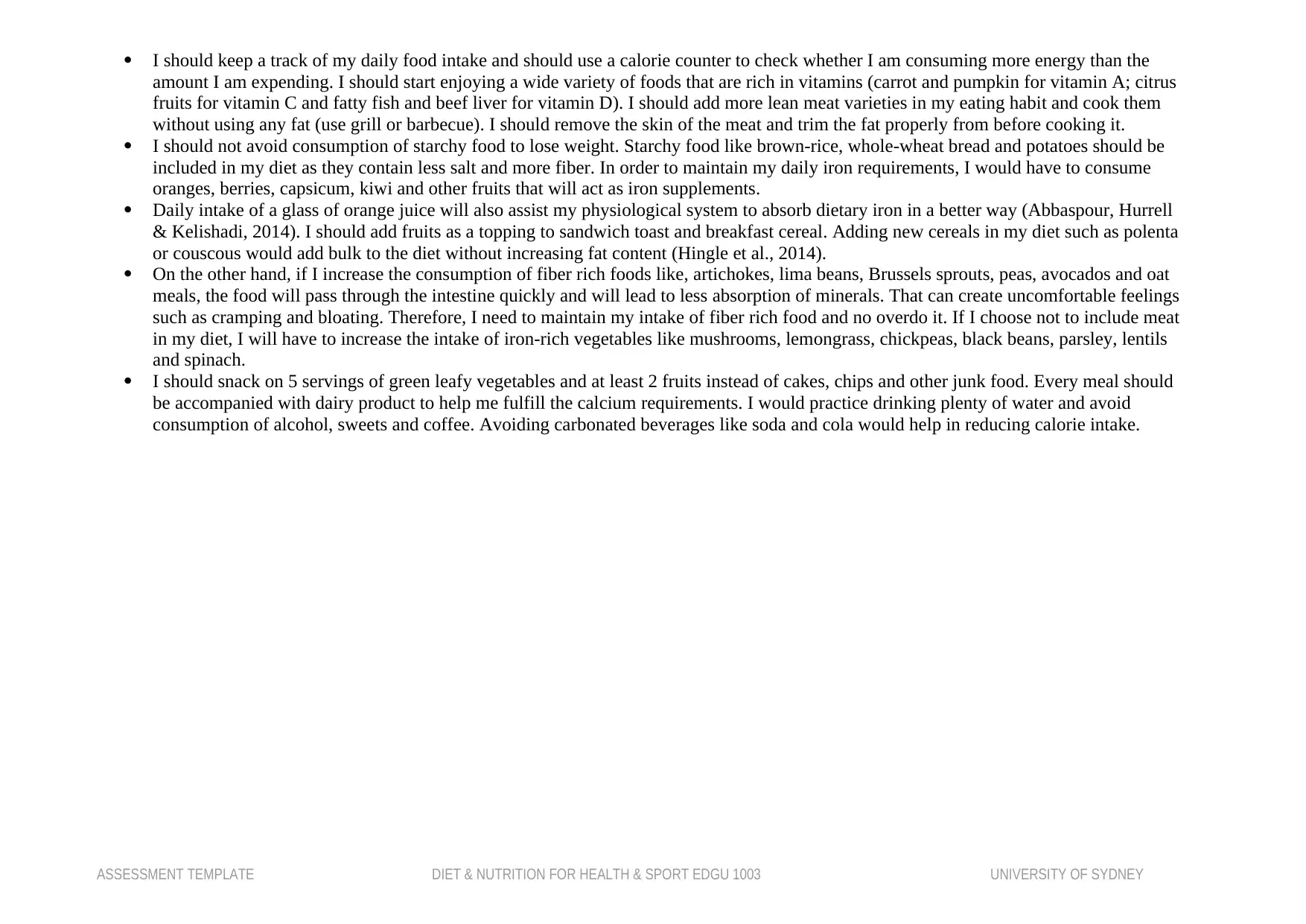
I should keep a track of my daily food intake and should use a calorie counter to check whether I am consuming more energy than the
amount I am expending. I should start enjoying a wide variety of foods that are rich in vitamins (carrot and pumpkin for vitamin A; citrus
fruits for vitamin C and fatty fish and beef liver for vitamin D). I should add more lean meat varieties in my eating habit and cook them
without using any fat (use grill or barbecue). I should remove the skin of the meat and trim the fat properly from before cooking it.
I should not avoid consumption of starchy food to lose weight. Starchy food like brown-rice, whole-wheat bread and potatoes should be
included in my diet as they contain less salt and more fiber. In order to maintain my daily iron requirements, I would have to consume
oranges, berries, capsicum, kiwi and other fruits that will act as iron supplements.
Daily intake of a glass of orange juice will also assist my physiological system to absorb dietary iron in a better way (Abbaspour, Hurrell
& Kelishadi, 2014). I should add fruits as a topping to sandwich toast and breakfast cereal. Adding new cereals in my diet such as polenta
or couscous would add bulk to the diet without increasing fat content (Hingle et al., 2014).
On the other hand, if I increase the consumption of fiber rich foods like, artichokes, lima beans, Brussels sprouts, peas, avocados and oat
meals, the food will pass through the intestine quickly and will lead to less absorption of minerals. That can create uncomfortable feelings
such as cramping and bloating. Therefore, I need to maintain my intake of fiber rich food and no overdo it. If I choose not to include meat
in my diet, I will have to increase the intake of iron-rich vegetables like mushrooms, lemongrass, chickpeas, black beans, parsley, lentils
and spinach.
I should snack on 5 servings of green leafy vegetables and at least 2 fruits instead of cakes, chips and other junk food. Every meal should
be accompanied with dairy product to help me fulfill the calcium requirements. I would practice drinking plenty of water and avoid
consumption of alcohol, sweets and coffee. Avoiding carbonated beverages like soda and cola would help in reducing calorie intake.
ASSESSMENT TEMPLATE DIET & NUTRITION FOR HEALTH & SPORT EDGU 1003 UNIVERSITY OF SYDNEY
amount I am expending. I should start enjoying a wide variety of foods that are rich in vitamins (carrot and pumpkin for vitamin A; citrus
fruits for vitamin C and fatty fish and beef liver for vitamin D). I should add more lean meat varieties in my eating habit and cook them
without using any fat (use grill or barbecue). I should remove the skin of the meat and trim the fat properly from before cooking it.
I should not avoid consumption of starchy food to lose weight. Starchy food like brown-rice, whole-wheat bread and potatoes should be
included in my diet as they contain less salt and more fiber. In order to maintain my daily iron requirements, I would have to consume
oranges, berries, capsicum, kiwi and other fruits that will act as iron supplements.
Daily intake of a glass of orange juice will also assist my physiological system to absorb dietary iron in a better way (Abbaspour, Hurrell
& Kelishadi, 2014). I should add fruits as a topping to sandwich toast and breakfast cereal. Adding new cereals in my diet such as polenta
or couscous would add bulk to the diet without increasing fat content (Hingle et al., 2014).
On the other hand, if I increase the consumption of fiber rich foods like, artichokes, lima beans, Brussels sprouts, peas, avocados and oat
meals, the food will pass through the intestine quickly and will lead to less absorption of minerals. That can create uncomfortable feelings
such as cramping and bloating. Therefore, I need to maintain my intake of fiber rich food and no overdo it. If I choose not to include meat
in my diet, I will have to increase the intake of iron-rich vegetables like mushrooms, lemongrass, chickpeas, black beans, parsley, lentils
and spinach.
I should snack on 5 servings of green leafy vegetables and at least 2 fruits instead of cakes, chips and other junk food. Every meal should
be accompanied with dairy product to help me fulfill the calcium requirements. I would practice drinking plenty of water and avoid
consumption of alcohol, sweets and coffee. Avoiding carbonated beverages like soda and cola would help in reducing calorie intake.
ASSESSMENT TEMPLATE DIET & NUTRITION FOR HEALTH & SPORT EDGU 1003 UNIVERSITY OF SYDNEY
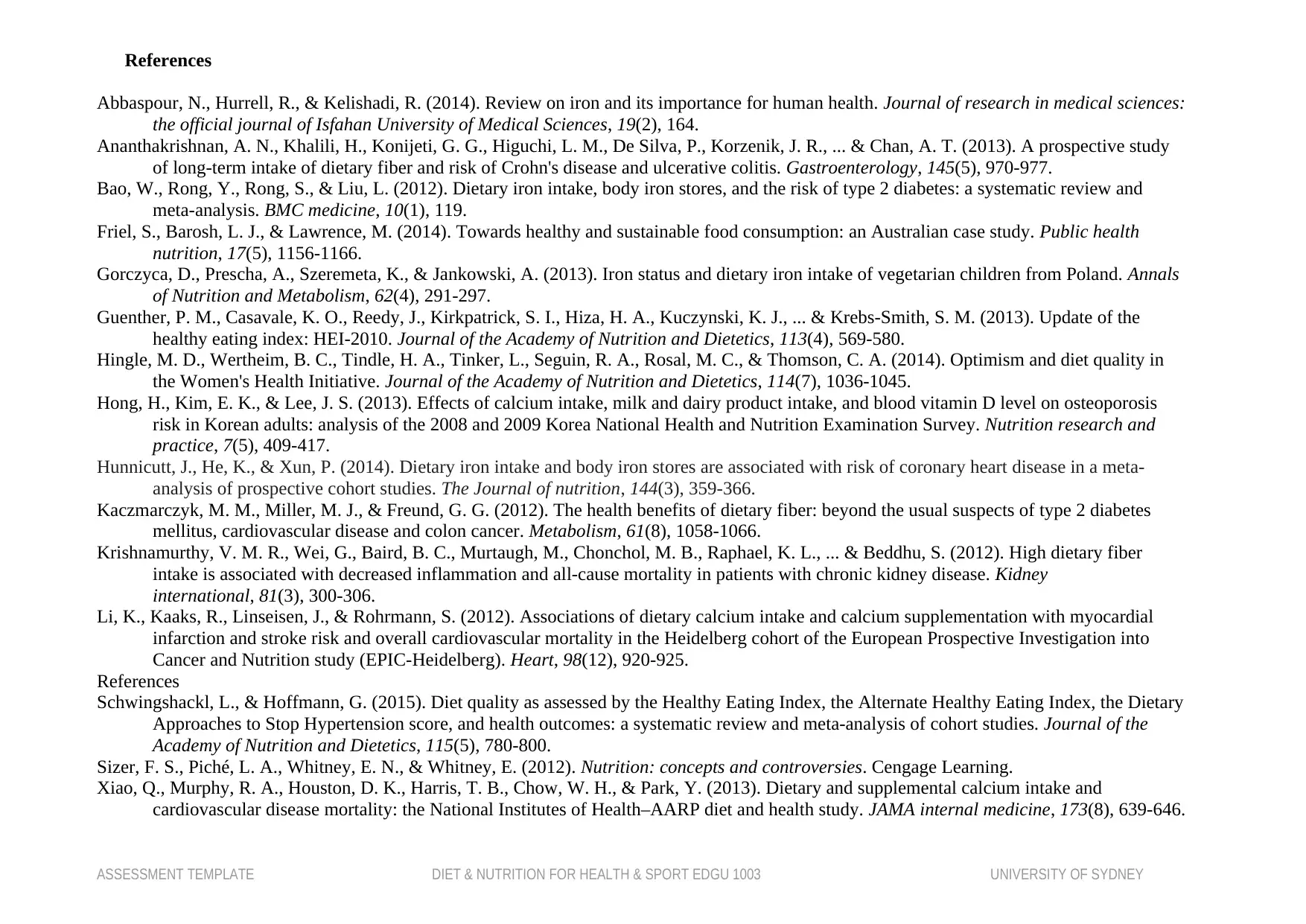
References
Abbaspour, N., Hurrell, R., & Kelishadi, R. (2014). Review on iron and its importance for human health. Journal of research in medical sciences:
the official journal of Isfahan University of Medical Sciences, 19(2), 164.
Ananthakrishnan, A. N., Khalili, H., Konijeti, G. G., Higuchi, L. M., De Silva, P., Korzenik, J. R., ... & Chan, A. T. (2013). A prospective study
of long-term intake of dietary fiber and risk of Crohn's disease and ulcerative colitis. Gastroenterology, 145(5), 970-977.
Bao, W., Rong, Y., Rong, S., & Liu, L. (2012). Dietary iron intake, body iron stores, and the risk of type 2 diabetes: a systematic review and
meta-analysis. BMC medicine, 10(1), 119.
Friel, S., Barosh, L. J., & Lawrence, M. (2014). Towards healthy and sustainable food consumption: an Australian case study. Public health
nutrition, 17(5), 1156-1166.
Gorczyca, D., Prescha, A., Szeremeta, K., & Jankowski, A. (2013). Iron status and dietary iron intake of vegetarian children from Poland. Annals
of Nutrition and Metabolism, 62(4), 291-297.
Guenther, P. M., Casavale, K. O., Reedy, J., Kirkpatrick, S. I., Hiza, H. A., Kuczynski, K. J., ... & Krebs-Smith, S. M. (2013). Update of the
healthy eating index: HEI-2010. Journal of the Academy of Nutrition and Dietetics, 113(4), 569-580.
Hingle, M. D., Wertheim, B. C., Tindle, H. A., Tinker, L., Seguin, R. A., Rosal, M. C., & Thomson, C. A. (2014). Optimism and diet quality in
the Women's Health Initiative. Journal of the Academy of Nutrition and Dietetics, 114(7), 1036-1045.
Hong, H., Kim, E. K., & Lee, J. S. (2013). Effects of calcium intake, milk and dairy product intake, and blood vitamin D level on osteoporosis
risk in Korean adults: analysis of the 2008 and 2009 Korea National Health and Nutrition Examination Survey. Nutrition research and
practice, 7(5), 409-417.
Hunnicutt, J., He, K., & Xun, P. (2014). Dietary iron intake and body iron stores are associated with risk of coronary heart disease in a meta-
analysis of prospective cohort studies. The Journal of nutrition, 144(3), 359-366.
Kaczmarczyk, M. M., Miller, M. J., & Freund, G. G. (2012). The health benefits of dietary fiber: beyond the usual suspects of type 2 diabetes
mellitus, cardiovascular disease and colon cancer. Metabolism, 61(8), 1058-1066.
Krishnamurthy, V. M. R., Wei, G., Baird, B. C., Murtaugh, M., Chonchol, M. B., Raphael, K. L., ... & Beddhu, S. (2012). High dietary fiber
intake is associated with decreased inflammation and all-cause mortality in patients with chronic kidney disease. Kidney
international, 81(3), 300-306.
Li, K., Kaaks, R., Linseisen, J., & Rohrmann, S. (2012). Associations of dietary calcium intake and calcium supplementation with myocardial
infarction and stroke risk and overall cardiovascular mortality in the Heidelberg cohort of the European Prospective Investigation into
Cancer and Nutrition study (EPIC-Heidelberg). Heart, 98(12), 920-925.
References
Schwingshackl, L., & Hoffmann, G. (2015). Diet quality as assessed by the Healthy Eating Index, the Alternate Healthy Eating Index, the Dietary
Approaches to Stop Hypertension score, and health outcomes: a systematic review and meta-analysis of cohort studies. Journal of the
Academy of Nutrition and Dietetics, 115(5), 780-800.
Sizer, F. S., Piché, L. A., Whitney, E. N., & Whitney, E. (2012). Nutrition: concepts and controversies. Cengage Learning.
Xiao, Q., Murphy, R. A., Houston, D. K., Harris, T. B., Chow, W. H., & Park, Y. (2013). Dietary and supplemental calcium intake and
cardiovascular disease mortality: the National Institutes of Health–AARP diet and health study. JAMA internal medicine, 173(8), 639-646.
ASSESSMENT TEMPLATE DIET & NUTRITION FOR HEALTH & SPORT EDGU 1003 UNIVERSITY OF SYDNEY
Abbaspour, N., Hurrell, R., & Kelishadi, R. (2014). Review on iron and its importance for human health. Journal of research in medical sciences:
the official journal of Isfahan University of Medical Sciences, 19(2), 164.
Ananthakrishnan, A. N., Khalili, H., Konijeti, G. G., Higuchi, L. M., De Silva, P., Korzenik, J. R., ... & Chan, A. T. (2013). A prospective study
of long-term intake of dietary fiber and risk of Crohn's disease and ulcerative colitis. Gastroenterology, 145(5), 970-977.
Bao, W., Rong, Y., Rong, S., & Liu, L. (2012). Dietary iron intake, body iron stores, and the risk of type 2 diabetes: a systematic review and
meta-analysis. BMC medicine, 10(1), 119.
Friel, S., Barosh, L. J., & Lawrence, M. (2014). Towards healthy and sustainable food consumption: an Australian case study. Public health
nutrition, 17(5), 1156-1166.
Gorczyca, D., Prescha, A., Szeremeta, K., & Jankowski, A. (2013). Iron status and dietary iron intake of vegetarian children from Poland. Annals
of Nutrition and Metabolism, 62(4), 291-297.
Guenther, P. M., Casavale, K. O., Reedy, J., Kirkpatrick, S. I., Hiza, H. A., Kuczynski, K. J., ... & Krebs-Smith, S. M. (2013). Update of the
healthy eating index: HEI-2010. Journal of the Academy of Nutrition and Dietetics, 113(4), 569-580.
Hingle, M. D., Wertheim, B. C., Tindle, H. A., Tinker, L., Seguin, R. A., Rosal, M. C., & Thomson, C. A. (2014). Optimism and diet quality in
the Women's Health Initiative. Journal of the Academy of Nutrition and Dietetics, 114(7), 1036-1045.
Hong, H., Kim, E. K., & Lee, J. S. (2013). Effects of calcium intake, milk and dairy product intake, and blood vitamin D level on osteoporosis
risk in Korean adults: analysis of the 2008 and 2009 Korea National Health and Nutrition Examination Survey. Nutrition research and
practice, 7(5), 409-417.
Hunnicutt, J., He, K., & Xun, P. (2014). Dietary iron intake and body iron stores are associated with risk of coronary heart disease in a meta-
analysis of prospective cohort studies. The Journal of nutrition, 144(3), 359-366.
Kaczmarczyk, M. M., Miller, M. J., & Freund, G. G. (2012). The health benefits of dietary fiber: beyond the usual suspects of type 2 diabetes
mellitus, cardiovascular disease and colon cancer. Metabolism, 61(8), 1058-1066.
Krishnamurthy, V. M. R., Wei, G., Baird, B. C., Murtaugh, M., Chonchol, M. B., Raphael, K. L., ... & Beddhu, S. (2012). High dietary fiber
intake is associated with decreased inflammation and all-cause mortality in patients with chronic kidney disease. Kidney
international, 81(3), 300-306.
Li, K., Kaaks, R., Linseisen, J., & Rohrmann, S. (2012). Associations of dietary calcium intake and calcium supplementation with myocardial
infarction and stroke risk and overall cardiovascular mortality in the Heidelberg cohort of the European Prospective Investigation into
Cancer and Nutrition study (EPIC-Heidelberg). Heart, 98(12), 920-925.
References
Schwingshackl, L., & Hoffmann, G. (2015). Diet quality as assessed by the Healthy Eating Index, the Alternate Healthy Eating Index, the Dietary
Approaches to Stop Hypertension score, and health outcomes: a systematic review and meta-analysis of cohort studies. Journal of the
Academy of Nutrition and Dietetics, 115(5), 780-800.
Sizer, F. S., Piché, L. A., Whitney, E. N., & Whitney, E. (2012). Nutrition: concepts and controversies. Cengage Learning.
Xiao, Q., Murphy, R. A., Houston, D. K., Harris, T. B., Chow, W. H., & Park, Y. (2013). Dietary and supplemental calcium intake and
cardiovascular disease mortality: the National Institutes of Health–AARP diet and health study. JAMA internal medicine, 173(8), 639-646.
ASSESSMENT TEMPLATE DIET & NUTRITION FOR HEALTH & SPORT EDGU 1003 UNIVERSITY OF SYDNEY
⊘ This is a preview!⊘
Do you want full access?
Subscribe today to unlock all pages.

Trusted by 1+ million students worldwide
1 out of 12
Related Documents
Your All-in-One AI-Powered Toolkit for Academic Success.
+13062052269
info@desklib.com
Available 24*7 on WhatsApp / Email
![[object Object]](/_next/static/media/star-bottom.7253800d.svg)
Unlock your academic potential
Copyright © 2020–2025 A2Z Services. All Rights Reserved. Developed and managed by ZUCOL.



